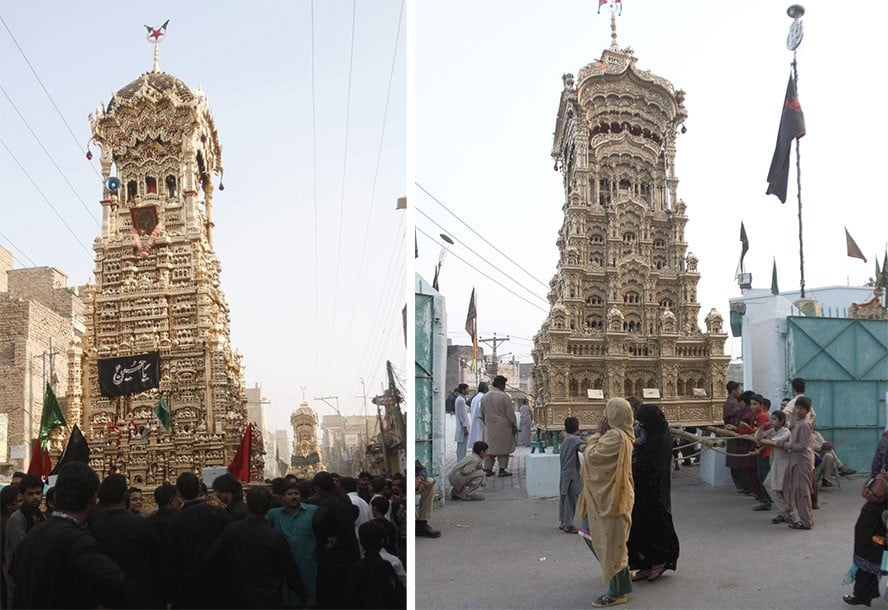

It is hard to imagine the towering Ustaad wala Tazia passing through the narrow alleys of the densely populated Muhallah Pir Qazi Jalal, in the Walled City, inside Pak Gate. But this is the regular 184 years old route of this tazia.
Taziyadari is a significant part of the Muharram mourning tradition in Multan. It stands for Imam Hussain’s mausoleum in Karbala (Iraq) and is taken out with respect to mark his martyrdom every year on the 10th of Muharram.
Multan is the leading centre of the oldest tazia tradition compared to Lahore, Rawalpindi and Faisalabad. The tazias of Multan are considered to be the tallest in all of the sub-continent.
More than 112 tazia processions are taken out on the 10th of Muharram in Multan every year, but some of the best known of these are the Ustaad and Shagird Tazias. The Tazia of Sakhi Lal Shah Al-Mashhadi Al-Mosvi is the third oldest Ziarat. Sakhi Lal Shah is considered to be the founder of the tazia tradition not only in Multan but also in parts of India and Pakistan. Thousands of devotees assemble to have a glimpse of both the tazias.
Ustaad wala Tazia
"I have been carrying these tazias on my shoulders ever since I was 16", says Shahzeb Hassan. "My late father used to say that doing this will absolve me of all my sins."
Hassan is 27, and currently the youngest license holder of Ustaad wala Tazia. The license was transferred in his name on the death of his father, Khalifa Altaf Hussein. Hassan belongs to the fifth generation of his family to hold this license. Hakim Rahim Buksh was the earliest license holder of the said tazia.
"About 150 faithful mourners carry Ustaad wala Tazia on their shoulders. The tazia is 28 feet high and weighs around 2,800 kilograms," he continues. "The interesting part is the width of the streets, which is just 8.5 feet; hence the tazia - which is eight feet wide - needs to be carried very carefully."
Ustaad Pir Bukhsh was the mason who started working on the said tazia in 1810 and completed the whole structure in 25 years, in 1835. Teak wood was used in the structure and the whole thing was built without the use of even a single nail anywhere. It takes at least seven hours to reach its final destination on Shah Risal road on the 10th of Muharram after travelling a distance of 2.5 kilometres.
"I heard from my forefathers that the tazia tradition in Multan begins with Madhu Pathan, a resident of Kabri Madhu Khan. He started this in response to a dream he had about taking a pilgrimage to Karbala," says Hassan."Madhu Khan also started observing the rituals of zuljinnah and alam during Muharram and led processions from Kubri Madhu Khan to Karbala Shah Risaal."
The tazia of the Ustaad leads all tazias and mourning processions whereas the Shagird wala tazia follows close behind, symbolising a student’s respect for his teacher.
Shagird wala Tazia
"The Shagird Tazia was prepared in 1853, twenty years after the completion of the Ustaad wala Tazia. It weighs 4,000 kilograms," says Muhammad Rais, who is the current license holder of the Tazia. Rais says that this tazia was constructed by Salman Ali, one of Pir Bukhsh’s students, who took inspiration from the Ustaadwala Tazia. This tazia was completed in 1854. It was 32 feet high, known as Shagirdwala Tazia, and larger than Ustaad wala Tazia. It was burnt by fundamentalists in 1944. However, it was quickly restored with the financial help of the local tribes, especially the Gardezis of Afghanistan.
"At least 200 people are required to carry the tazia on the 10th of Muharram. We place it at the top of the Khooni Burj for everyone to take a look at it easily," Rais says.
Senior faculty member, Bahauddin Zakariya University, Department of Pakistan Studies, Prof Dr Javed Salyana says that British government gave the first official license for Muharram processions to the tazia of the Ustaad in 1860, allowing the bearer to organise and lead religious processions. The local authorities issue the license and transfer to the next custodian of tazia.
Sakhi Lal Shah Tazia
The Sakhi Lal Shah Tazia is taken out in one of the oldest processions of South Punjab. It is at least 247 years old, and takes place every year to commemorate the 10th of Muharram.
Makhdoom Hassan Raza Mashhadi is the current caretaker of Astana Pir Syed Lal Shah Al-Mosvi Al Mashhadi. "My forefather Pir Syed Lal Shah laid the foundation of the Safavid dynasty in Iran and was the founder of the tazia culture in the sub-continent in 1807 AD. He arrived in Multan in 1820 AD and established an Imambargah at the western bank of River Ravi. He is considered the founder of the mourning tradition in the sub-continent."
One of the family elders who is buried in Chakwal, Hazrat Zeenatul Abideen set up the mourning processions in Gurdaspur, Poonch, Kashmir, Puna [India], Murshidabad [Bengal], Karachi, interior Sindh Larkana, Sukkur, Dera Ghazi Khan, Dera Ismael Khan, Bhakkar, Jhang, and 46 other cities. He also established an Imambargah in Kot Deji.
Raza says, "Pir Lal Shah prepared a wood tazia in 1710 during the time of Amir Taimur. The saint had installed a 110 feet high alam (flag) during the period of Dewan Sawan Mal at his Imambargah, and the tradition continues.
"My grandfather Sakhi Lal Shah spent a sizeable amount of time preaching in the muhallas of Jhik and Jawadia. The mourning processions of both the muhallas end up at the Imambargah Sakhi Lal Shah as a mark of respect for his services for the last 150 years.
"There’s great respect for Sakhi Lal Shah in the region. People from all over the country attend these processions. All the processions reach the Imambargah Sakhi Lal Shah to offer condolences on the death of the grandson of Prophet Muhammad [PBUH], Hazrat Imam Hussein A.S."